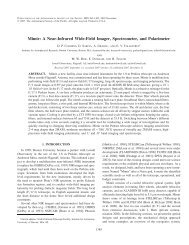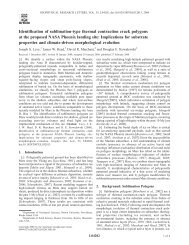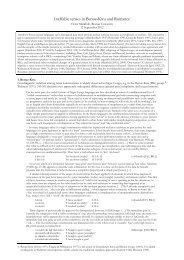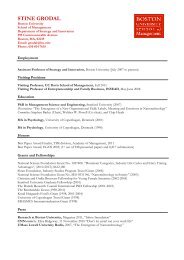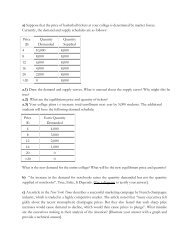Intertemporal Substitution and Recursive Smooth Ambiguity ...
Intertemporal Substitution and Recursive Smooth Ambiguity ...
Intertemporal Substitution and Recursive Smooth Ambiguity ...
You also want an ePaper? Increase the reach of your titles
YUMPU automatically turns print PDFs into web optimized ePapers that Google loves.
is ambiguity averse if he prefers a sure lottery obtained as the mean value of a given act tothe act itself.Definition 3 The decision maker with {≽ s t} exhibits ambiguity aversion if for all s t , forall c ∈ C <strong>and</strong> g +1 ∈ G +1 ,(c, m(g +1 , µ s t)) ≽ s t (c, g +1 ).Similarly to this definition, we can define ambiguity loving <strong>and</strong> ambiguity neutrality inthe usual way. An immediate consequence of this definition is the following:Proposition 1 Suppose {≽ s t} satisfies Axioms A1-A7. Then {≽ s t} exhibits ambiguity aversionif φ ≡ v ◦ u −1 is concave. 16The proof of this proposition is straightforward <strong>and</strong> is omitted. Clearly, when v ◦ u −1is linear, {≽ s t} displays ambiguity neutrality. Thus, the ambiguity neutrality benchmark isthe recursive expected utility model. We need additional conditions to establish the conversestatement that ambiguity aversion implies concavity of v ◦ u −1 . The reason is that, to provethis statement, one needs to know preferences over binary bets on some P s t, but our axioms<strong>and</strong> representation hold only for fixed P s t. To deal with this issue in the KMM model, KMM(2005) consider a family of preference relations indexed by rich supports of second-orderbeliefs, <strong>and</strong> impose an assumption that ambiguity attitude <strong>and</strong> risk attitude are invariantacross these supports (see their Assumption 4). We can adapt their assumption to establishthe converse statement. Since the proof is similar to their proof of Proposition 1 in theirpaper, we omit it here.We now turn to comparative ambiguity aversion.Definition 4 Let the representations of the preferences of persons i <strong>and</strong> j share the samesecond-order belief µ s t on the same support P s t for all s t . Say that {≽ i s} is more ambiguitytaverse than {≽ j s} if for all s t , for all c ∈ C, m ∈ M <strong>and</strong> g t +1 ∈ G +1 ,(c, m) ≽ j s(c, g t +1 ) =⇒ (c, m) ≽ i s (c, g +1),t<strong>and</strong> if this property also holds for strict preference relations ≻ i s<strong>and</strong> ≻ j t s. t16 It is easy to check if v ◦ u −1 is concave, {≽ s t} satisfies the uncertainty aversion axiom of Gilboa <strong>and</strong>Schmeidler (1989).17



